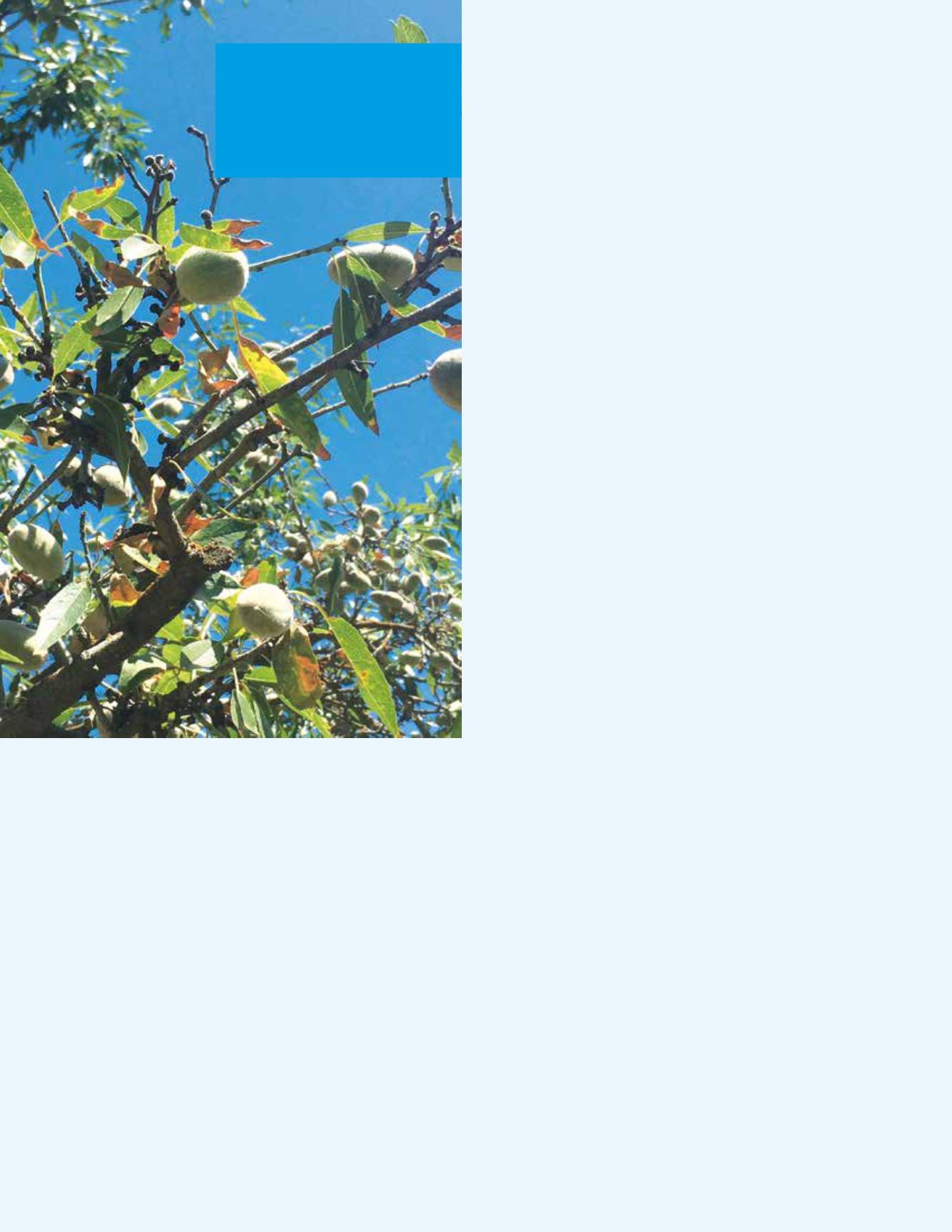
MAY | JUNE 2017
Almond Facts
35
symptoms are found throughout the orchard – the earlier
the better.
Treatment for other diseases such as anthracnose and scab
are not effective at this time. These applications should
have occurred earlier in the season to reduce populations.
Applying material now for these diseases may help with
sleep, but will provide no reduction of crop loss or leaf drop.
Keep an eye out for bacterial spot, especially in the northern
San Joaquin Valley. This relatively new disease has been
affecting almond orchards. Symptoms include amber
gumming from nuts, with a lesion about ¼-inch in diameter
that could extend to the shell, and small, pinhole sized lesions
on leaves with a yellow halo. It severely affects ‘Fritz’ and
‘Padre’ with infections on other varieties found. Treatments
will have to be planned for the dormant and spring of 2018 to
manage this disease.
Hull-Rot Management
Hull rot is a fungal infection of the splitting hull by either
Rhizopus stolonifer
or
Monilinia
spp
.
Toxins produced by these
fungi move into the tree, killing spurs and wood within the
canopy, impacting future production. Trees that are over-
fertilized and over-irrigated tend to have increased hull-rot.
Nitrogen applications should be minimized after kernel fill
and, if possible, RDI should be applied.
Fungicides have been shown to be effective in reducing
strikes by
Rhizopus
, but must be timed to the initial splitting
of the almond hull. This usually coincides with NOW
sprays. Hull split fungicide sprays, however, do not reduce
hull rot by
Monilinia
spp. Data indicates that fungicides for
Monilinia
need to be applied in early to mid June to reduce
latent infections of the hull. Fungicides when used without
RDI and nitrogen management practices have generally
shown a reduction of only 10-25% of hull rot infections, and
highlights the value of an integrated program.
Recent research has found that alkalizing treatments applied
at hull split are able to reduce the severity of hull rot to
the level similar to many fungicides. These high pH spray
solutions are thought to neutralize the acid compounds that
are produced by the hull rot pathogens and responsible for
twig dieback. Materials that have been found to increase
spray solution pH include lime, dipotassium phosphate, and
others. Research is ongoing for optimization in the use of
these products.
Managing Navel Orangeworm
If navel orangeworm (NOW) populations are high, hull-split
sprays should be made to protect the crop from infestation.
Sprays should be made at the onset of hull-split (e.g. 1-5%).
Often at this time, blanks begin to split in the interior of the
orchard. Most reduced-risk pesticides need to be applied
prior to egg laying or hatching, supporting this earlier timing.
Pyrethroids (e.g. Brigade, Warrior), organophosphates (e.g.
Lorsban), and chlorantraniliprole (e.g. Altacor) as well as a
few other combination products have shown adult activity
and may be suitable for later timed hull-split sprays. Although
lower in cost, pyrethroids have been shown to impact spider
mite predators for at least 6 months after the application,
increasing the risk of spider-mite flare-ups into the following
year. Second sprays for ‘Nonpareils’ and coverage for later
splitting pollinators may be needed, especially in areas with
higher temperatures and NOW populations. Work with your
pest control advisor to determine the best strategy for timings
and pesticide selection.
Alternaria was prevalent in many areas in
2016 due to late rains and extended periods
of leaf wetness. Treatment timings should
be determined using the Alternaria DSV
model and can help prevent the occurrence
of this disease. Treatments must occur
prior to infections are visible for maximum
effectiveness. Photo credit: David Doll.


